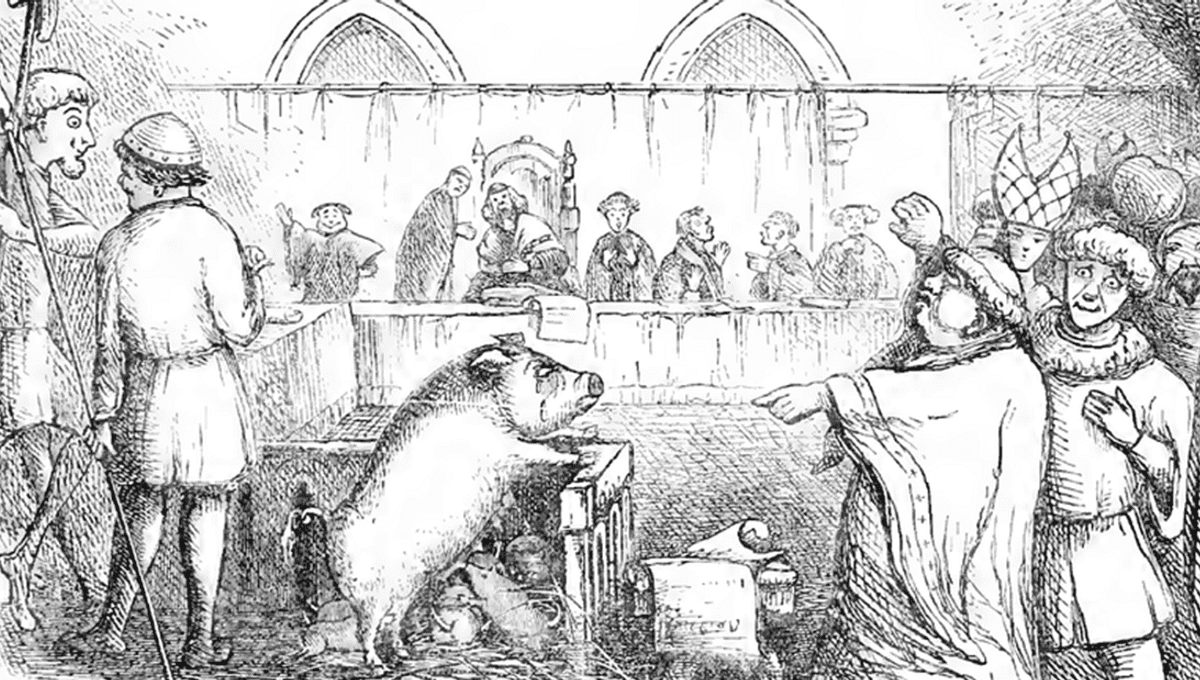
Picture the scene: you are a medieval lawyer, getting your client ready for court. Your client has been accused of the most heinous of crimes, witchcraft, after claims that they laid an egg. To complicate matters further, your client is a chicken.
This, minus a fancy lawyer for the defense, is what happened in Basel in 1474, when a rooster was sentenced to be burned alive “for the heinous and unnatural crime of laying an egg” after a number of eggs were found in his enclosure. The subsequent (presumably Nandos-smelling) execution was observed “with as great solemnity as would have been observed in consigning a heretic to the flames, and was witnessed by an immense crowd of townsmen and peasants”.
Perhaps surprisingly, this is far from the only trial of an animal in history, with everything from bears to monkeys not immune from human legal proceedings. Sometimes, as was the case in 1386 in Falaise, France, the animals were dressed before the execution. The pig in question was convicted of murdering an infant and dressed in a waistcoat, underwear, and gloves before being led to the gallows. It was then mutilated with a knife before being hung.
Animal trials in Europe were carried out in the same seriousness as trials for humans, according to historian Peter Dinzelbacher, with the usual members of court in attendance, who were paid as if for an ordinary human trial, rather than the lower rate you might expect when considering whether to hang a grasshopper for eating grain. Attention was even paid to the motives of the animal, with one sow in 1567 being hanged for assaulting a baby and for doing so with “cruelty“.
Not all animals put on trial were sentenced to death. One drummer’s dog bit a municipal councilor in Austria on the leg. When the owner refused to take responsibility for the dog’s actions, the consequences fell to the dog, who was placed on trial and found guilty. Rather than being executed, the dog was sentenced to a year in “Narrenkötterlein”, an iron cage in the middle of town where criminals and blasphemers were confined to be mocked and pilloried.
Pigs were commonly put on trial, mainly for crimes that involved fatalities, while any animals that were unfortunate to be victims of bestiality were usually condemned to death for the act. These trials took place through much of the middle ages, with Europe leading the “try that snail like a human” way.
In a much more recent execution of an animal, Mary the Elephant was hung by a crane until her death in Tennessee after being accused of murder. On September 12, 1916, Mary the Circus elephant killed Red Eldridge, a circus worker assigned to ride her.
According to accounts from the time, the elephant either killed Eldridge with one blow of her trunk or went on a murderous rampage and “lifted him 10 feet [3 meters] in the air, then dashed him with fury to the ground… and with the full force of her biestly [sic] fury is said to have sunk her giant tusks entirely through his body. The animal then trampled the dying form of Eldridge as if seeking a murderous triumph, then with a sudden… swing of her massive foot hurled his body into the crowd.”
Either way, crowds began to chant “kill the elephant”, leading to several attempts at execution. The first method – shooting Mary – had little impact, with the circus manager noting “there ain’t gun enough in this country that he could be killed”. Electrocution was either carried out – one railroad worker claimed that 44,000 volts had merely made her “dance a bit” – or not carried out due to a lack of power to carry out the execution.
In the end, though, Mary was hung using a crane as a crowd of 2,500 people watched. At first, the chains broke, resulting in a broken hip for the animal. A stronger chain was used to finish the job: a modern-day execution of an animal for murder. At least in the middle ages they had trials.
Source Link: Animal Trials And The Elephant That Was Hanged For Murder